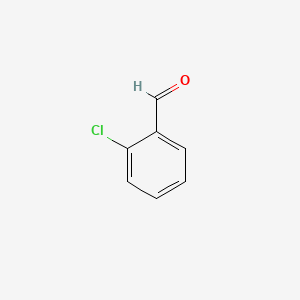

1. 89-98-5
2. O-chlorobenzaldehyde
3. Chlorobenzaldehyde
4. Benzaldehyde, 2-chloro-
5. Benzaldehyde, O-chloro-
6. 2-chlorbenzaldehyd
7. 2-clorobenzaldeide
8. O-chloorbenzaldehyde
9. 2-chloro-benzaldehyde
10. Usaf M-7
11. 2-chloorbenzaldehyde
12. O-chlorobenzenecarboxaldehyde
13. 2-chloro Benzaldehyde
14. Benzaldehyde,chloro-
15. Nsc 15347
16. 35913-09-8
17. Mfcd00003304
18. Qhr24x1lxk
19. Nsc-15347
20. 2-chlorbenzaldehyd [german]
21. O-chloorbenzaldehyde [dutch]
22. 2-chloorbenzaldehyde [dutch]
23. 2-clorobenzaldeide [italian]
24. Ccris 5991
25. Benzaldehyde, Chloro-
26. Hsdb 2727
27. Einecs 201-956-3
28. Unii-qhr24x1lxk
29. Chlorotoluon
30. Ai3-04254
31. O-chlorobezaldehyde
32. 2-chlorobezaldehyde
33. 6-chlorobenzaldehyde
34. O-chloroformylbenzene
35. O-chloro Benzaldehyde
36. Orthochlorobenzaldehyde
37. 2- Chlorobenzaldehyde
38. 2-chlorobenzenaldehyde
39. Nsc 174140
40. (2-chloro)benzaldehye
41. Ortho-chlorobenzaldehyde
42. (2-chloro)benzaldehyde
43. (2-chloro) Benzaldehyde
44. Wln: Vhr Bg
45. Dsstox_cid_4764
46. Ec 201-956-3
47. 2-chlorobenzaldehyde, 99%
48. Dsstox_rid_77522
49. Dsstox_gsid_24764
50. Schembl97422
51. Mls001056242
52. Chlorobenzaldehyde, O-
53. Chembl1547989
54. Dtxsid5024764
55. Amy39073
56. Nsc15347
57. Str00143
58. Zinc1706909
59. Tox21_200373
60. Stl146016
61. Akos000119188
62. Cs-w003973
63. Cas-89-98-5
64. Ncgc00091218-01
65. Ncgc00091218-02
66. Ncgc00257927-01
67. Smr001216556
68. Ds-006490
69. Ft-0611908
70. Ft-0611909
71. Ft-0658390
72. D77644
73. Q2195231
74. W-100351
75. 2-chlorobenzaldehyde, Purum, Dist., >=98.0% (gc)
76. F2190-0599
| Molecular Weight | 140.56 g/mol |
|---|---|
| Molecular Formula | C7H5ClO |
| XLogP3 | 2.3 |
| Hydrogen Bond Donor Count | 0 |
| Hydrogen Bond Acceptor Count | 1 |
| Rotatable Bond Count | 1 |
| Exact Mass | 140.0028925 g/mol |
| Monoisotopic Mass | 140.0028925 g/mol |
| Topological Polar Surface Area | 17.1 Ų |
| Heavy Atom Count | 9 |
| Formal Charge | 0 |
| Complexity | 103 |
| Isotope Atom Count | 0 |
| Defined Atom Stereocenter Count | 0 |
| Undefined Atom Stereocenter Count | 0 |
| Defined Bond Stereocenter Count | 0 |
| Undefined Bond Stereocenter Count | 0 |
| Covalently Bonded Unit Count | 1 |
2-Chlorobenzaldehyde might be produced when a moist skin is exposed to the riot control agent CS. CS-hydrolysis to 2-chlorobenzaldehyde and malononitrile occurs both in vitro and in vivo. No quantitative data have thus far been reported with respect to the percutaneous absorption and the cutaneous biotransformation of 2-chlorobenzaldehyde. Percutaneous absorption, biotransformation and elimination of (14)C-labeled 2-chlorobenzaldehyde was investigated in the rat. Following IV (25 uL/kg) and IP (37.5 uL/kg) (14)C-2-chlorobenzaldehyde administration to rats, the plasma radioactivity declined rapidly over a 24 hr period with similar plasma radioactivity-time profiles. Following cutaneous administration (75 uL/kg) in a closed glass-cup on the skin a slow skin penetration occurred as indicated by plasma radioactivity levels. A slow increase in plasma radioactivity was followed by a slow decline of radioactivity in plasma over a 3-day period. Most of the radioactivity was found in the urine with low levels in feces and exhaled air. The cutaneously administered radioactivity was also partly recovered from the glass-cup. For the qualitative and quantitative determination of metabolites in urine, a thin layer chromatography-radioautography method was used. The metabolic patterns of urinary excreted metabolites following cutaneous application and systemic administration of (14)C-2-chlorobenzaldehyde to rats were very similar. No parent compound was recovered from the rat urine. 2-Chlorohippuric acid was the principal urinary metabolite. Quantitatively, the urinary excretion of (14)C-2-chlorobenzyl alcohol following cutaneous application differed substantially from that after the systemic administration. There was no evidence of storage in the skin or skin toxicity of 2-chlorobenzaldehyde following cutaneous application.
PMID:3243317 Rietveld EC et al; Eur J Drug Metab Pharmacokinet 13 (4): 231-40 (1988)
Main metabolic pathways of o-chlorobenzylidene malononitrile (CS) in rabbits were estimated quantitatively following iv administration. The products of hydrolysis were o-chlorobenzaldehyde (o-Cbald) and malononitrile. The toxic actions of CS can be ascribed to o-Cbald.
Paradowski M; Pol J Pharmacol Pharm 31 (6) 563 (1980)
Male adult Wistar rats dosed i.p. with o-substituted benzaldehydes (o-F, o-Cl, and o-Br = V, VI, and VII) excreted mercapturic acids in urine. These acids were identified as N-acetyl-S-(ortho-substituted benzyl)cysteines (I, II, III). The total mercapturic acid excretion as % dose (2.0 mmol/kg, n = 4) was 1.2 +/- 0.4, 6.8 +/- 0.9, and 10.4 +/- 2.0 for V, VI, and VII. p-Cl-benzaldehyde administered in the same dose showed a non-significant urinary thioether excretion. The aim of the investigation was to prove in vivo a postulated metabolic pathway of substituted benzaldehydes via sulfate esters to mercapturic acids. After a single administration of the sodium salts of o- and p-Cl-benzylsulfuric acid a significant increase in mercapturic acid excretion of 21.2 +/- 1.8% and 14.5 +/- 1.2% of dose (2.0 mmol/kg, n = 4) was found. By pretreatment with pyrazole the mercapturic acid excretion increased after administration of o-Cl-benzyl alcohol (IX) whereas a significant decrease was found after administration of o-Cl-benzaldehyde (VI). After simultaneous administration of ethanol with IX and VI an increase in mercapturic acid excretion was observed. After previous administration of pentachlorophenol a significant decrease in urinary mercapturic acid excretion for IX and VI was found. These findings are in accordance with a metabolic pathway of substituted benzaldehydes via benzyl alcohols, subsequently sulfate esters to the corresponding benzylmercapturic acids.
PMID:6860142 Rietveld EC et al; Arch Toxicol 52 (3) 199-207 (1983)
In cat blood in vivo, o-chlorobenzaldehyde had /a/ half /life/ of ... 9.5 s.
PMID:4714331 Leadbeater L; Toxicol Appl Pharmacol 25 (1) 101-10 (1973)
